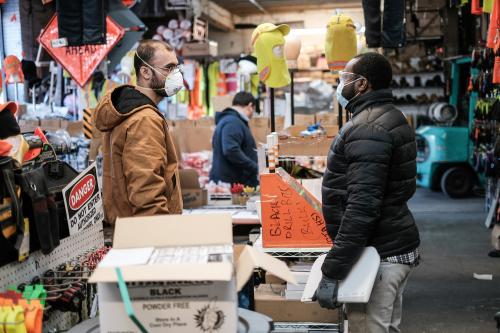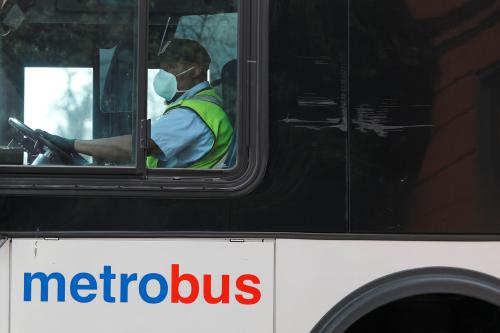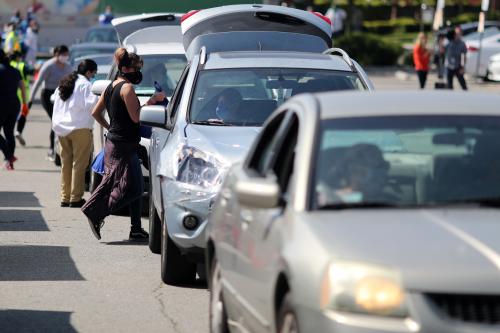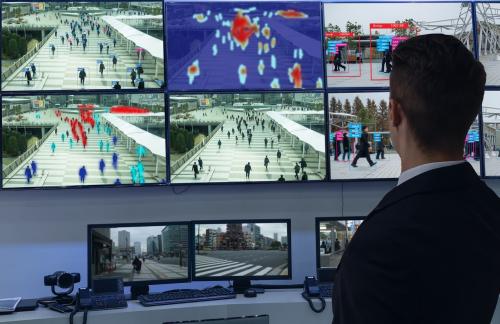Over the past two months, the coronavirus pandemic has devastated large swaths of the U.S. labor market, with more than 36 million American workers filing claims for unemployment insurance. Just last week, the Bureau of Labor Statistics (BLS) reported that the national unemployment rate reached 14.7% by mid-April, its highest level since the Great Depression—even as the agency acknowledged that the rate is likely considerably higher.
While few corners of the U.S. economy have been unaffected by the pandemic, some places have suffered more and/or earlier than others due to factors such as the path of the virus within U.S. borders and the vulnerability of local industries to consumer and government actions. Recently, Brookings Metro examined BLS data on job loss and unemployment trends through the middle of March, as those actions were just taking shape. However, BLS publishes those data roughly six weeks after the underlying survey is conducted, making them somewhat out-of-date amid a rapidly changing labor market.
Initial unemployment insurance (UI) claims may provide a more current picture of regional labor market volatility. Each week, states report the preceding week’s data on initial UI claims to the U.S. Department of Labor. For this analysis, Brookings Metro compiled sub-state weekly data on those claims (where available) to examine metropolitan-level trends.
Many states publish these data—typically by county—on the websites of their departments of labor or workforce development each week. However, not all states publish such data; some provide no sub-state data, while others provide those data only on a monthly or cumulative basis.
Overall, we identified 27 states and the District of Columbia that provided weekly initial UI claims data by county (or equivalent) for the weeks ending March 21 through April 11. These data allowed us to explore UI claims trends for 111 of the 192 U.S. metro areas with populations of at least 250,000. (If a metro area spanned multiple states and data were available by county in one or more of those states but not others, we included the metro area if constituent counties with data accounted for at least 75% of employment for the whole metro area.)

Initial UI claims were most widespread in tourism hubs and regions hit earlier by the virus
As an early Brookings Metro analysis suggested, some cities felt the initial brunt of the COVID-19 recession earlier than others. Comparing total claims across the four weeks to initial employment totals by metro area shows that in just one month, as many as one-quarter of all workers in tourism destinations such as Las Vegas, New Orleans, and Myrtle Beach, S.C. lost their jobs, as work in hotels, casinos, and entertainment hubs quickly dried up.
Another set of heavily impacted metro areas not only possessed vulnerable industries and workers, but also are located in states where public officials took earlier action to contain the virus’s spread. California’s Riverside-San Bernardino, Stockton, and Vallejo metro areas saw unemployment claims rise dramatically in the wake of Governor Gavin Newsom’s stay-at-home order on March 19. The same was true of the Youngstown and Toledo metro areas in Ohio, which, on March 15, became one of the first states to shutter all bars and restaurants. These metro areas saw greater shares of their workers affected than other metro areas in those states, such as the San Francisco Bay Area and Ohio’s three largest metro areas (Cleveland, Columbus, and Cincinnati), where larger white-collar workforces were not subject to the same high levels of immediate displacement.
In a different set of metro areas, the share of workers filing initial UI claims in the early weeks of the crisis was much smaller. In Texas, for instance, initial UI claims represented no more than 10% of local employment in any metro area; in many of the state’s midsized metro areas, the share was only 5% to 6%. This reflected not only Texas’s below-average rates of COVID-19 infection in March and April, but also the fact that Governor Greg Abbott let local officials make decisions about shutdowns before finally issuing a statewide stay-at-home order effective April 2. In Georgia, where Governor Brian Kemp only issued such an order on April 3, layoffs were already widespread in regions such as Atlanta and Savannah, as local officials took earlier action to limit the virus’s spread.

Another factor that may contribute to differences across counties and states in the prevalence of these claims is the responsiveness of their UI systems. Research from the Economic Policy Institute finds that for every 10 people who successfully filed for UI benefits between mid-March and mid-April, at least three more tried but couldn’t get through. Some states have purposely made it more burdensome for people to apply for UI benefits, while others have simply failed to update or upgrade computer systems that handle such applications.
Initial claims were still high or rising in several metro areas by mid-April
From mid-March through mid-April, roughly 20 million workers nationwide filed initial UI claims. The worst weeks were those ending March 28 and April 4, when UI benefit rolls swelled by 6 million claimants each week. Laid-off workers filed another 5 million initial claims the week ending April 11, followed by 10 million more over the succeeding three weeks.
Across the metro areas analyzed here, initial claim totals were also highest for the weeks ending March 28 and April 4. Of the 111 metro areas, 98 registered their highest weekly total during one of those weeks.
Yet in some metro areas, initial UI claims were rising or remained high as of mid-April. Regions in Indiana, South Carolina, and even the Seattle metro area (where the virus is thought to have initially entered the United States) either met a new weekly high for UI claims or were still above 80% of their peak weekly claims for the week ending April 11. Again, these patterns may reflect differences in state UI system responsiveness, but they may also signal the spread of the economic contagion into industries “upstream” from immediately affected sectors of hospitality and retail.

Local UI claims can be useful ‘real time’ indicators of labor market conditions
Because they are reported weekly, data on metro areas’ initial UI claims offer insights into the health of local economies that are something closer to real time than official labor market surveys. Moreover, they show that the impacts of this downturn are not being felt evenly across the country, nor even within states—illustrating the need for tailored assistance to heavily affected areas.
But the insights are only as complete as the data behind them. Although this analysis manages to cover a majority of major U.S. metro areas, too many states fail to make sub-state UI data accessible to the public. The availability of these data doesn’t fall neatly along regional, demographic, or blue/red state lines; it just seems to appear in some places and not in others.
The U.S. Department of Labor could help by requesting that states submit initial UI claims data by county at the same time they submit their statewide totals each week. Not all states may have the capacity to report such data right away, but federal encouragement would signal the value of this information, and would enable the reporting of these data in one place as opposed to the dozens of mercurial state agency websites we scoured.
Until then, we’ll continue tracking and analyzing these data state by state, metro area by metro area, to chart the depth and breadth of the labor market challenges facing American communities.
The author thanks Sarah Crump and Caroline George for research assistance, including wading through 51 state Department of Labor websites.







Commentary
What weekly unemployment claims reveal about the local impacts of the COVID-19 recession
May 14, 2020